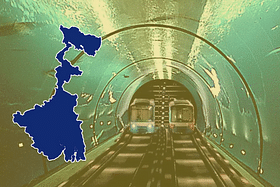Snapshot
-
The metro route between Howrah and Sealdah cuts down travel time for commuters to 40 minutes as against 1.5 hours by road.
The metro project, including underground tunnel, is expected to be completed by December 2023.
Racing against time, India’s first underwater Metro tunnel is coming up at a cost of around Rs 120 crore, part of the East West Metro Corridor in West Bengal.
A technological marvel, the underwater tunnel will be a blink and miss experience for passengers who will spend just 45 seconds in the 520 metre tunnel between Howrah Maidan and Mahakaran.
The underwater tunnel under the river Hoogly– the Indian version of Eurostar’s London-Paris corridor is 13 metres below the Hooghly riverbed and 33 metre below ground level.
A significant part of the East West Metro corridor of Kolkata which is aligned from Salt Lake-V, an IT Hub in the east to Howrah Maidan in the west across river Hooghly, has a 520 meter tunnel that is now complete.
However, the remaining 2.5 km stretch between Esplanade and Sealdah is still under construction and is expected to be commissioned in December 2023.
“The tunnel is essential for the East West Corridor and it was key. The under the river alignment was the only alignment possible with residential areas and other technical issues involved.
“This metro route between Howrah and Sealdah cuts down travel time for commuters to 40 minutes as against 1.5 hours by road on that route. It will also ease congestion at both ends,” said Sailesh Kumar, General Manager, Civil, Kolkata Metro Rail Corporation.
The East West Corridor of the Metro Rail has been marred by delays which has resulted in cost escalations. It was approved in 2009 at a cost of Rs 4,875 crore and a completion date of August 2015.
Seven years later, the cost has increased to Rs 8,475 crore out of which the expenditure has been Rs 8,383 crore already.

The tunnel will have an internal diameter of 5.55m and an external diameter of 6.1m. The spacing between the tunnels will be 16.1m centre-to-centre.
The inner walls of the tunnel are being made with reinforced concrete segments with a thickness of 275mm each. Six of these segments will complete a circular lining of the tunnel’s diameter. The segments are being pre-cast in specialised moulds imported from Korea.
Several protective measures have been taken to prevent water inflow and leakages in the tunnel. Concrete mixes composed of fly ash and micro silica have been used for the segments to minimise water permeability.
The segments are being sealed using a complex grouting process that will fill the space between the segments and the shield of the tunnel boring machine (TBM).
A two-component grout mix, including slurry made of water, cement and bentonite and sodium silicate, is being used to fill the gaps. The liner segments are fitted with German-made neoprene and hydrophilic auxiliary gaskets, which expand when in contact with water to prevent inflow through segmental joints.
Two German-made tunnel boring machines (TBMs), named Prerna and Rachna, were deployed for the process.
Emergency evacuation shafts up to 760m in length are being provided inside the tunnel to adhere to National Fire Protection Association (NFPA) guidelines. The evacuation shafts are being provided in Howrah Station in the west and Strand Road in the east to improve passenger safety.
There are various reasons for the delay including Barabazar casualty and changes in the realignment. However, the site engineer said the East West Metro project including underground tunnel is expected to be completed by December 2023.
- ,


